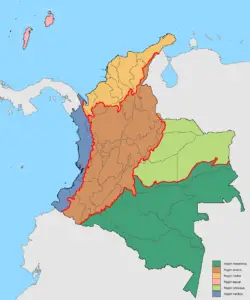Colombia-MICE is part of the Pelecanus Travel Group. We are located in Bogota, Colombia. We are specialized in corporate travel and all services around Meetings, Incentives, Conferences, and Exhibitions.
The main industries in Colombia that contribute to the country’s economy and its economic sectors are agriculture, livestock, mining, energy, industry and fisheries.
The main export sectors are agriculture, mining, industry and fisheries, which are developing in different regions of the country. But what you may not know is that Colombia is made up of 6 natural regions with an enormous variety of geographical aspects, industries, traditions, accents and gastronomy.
Therefore, below we present everything you need to know about the different economic sectors of Colombia and the contribution of its regions (Caribbean, Pacific, Andes, Orinoco, Island and Amazon) to the market and economic development of the country.
Content
The main economic sectors of Colombia
The Colombian Agricultural Sector
The agricultural sector, also known as the agricultural sector, is one of the most important sectors in the country and the primary sector. Products such as palm oil, coffee, cocoa, bananas and flowers are produced.
Products of the agricultural sector in Colombia
Colombia is among the 5 largest producers in the world for:
- Coffee
- avocado
- Palm oil
The country is among the top 10 world producers of:
- sugar cane
- bananas
- pineapple
- cocoa
Colombian Agricultural Sector Exports
In 2020, the main destinations of the country’s agricultural and agro-industrial exports were as follows:
| Destination country | % share of exports | Export dollar value | Tons |
| USA | 38,4% | US $1.723 millions | 651.305 |
| Netherlands | 5,7% | US $257 millions | 276.964 |
| Belgium | 5,0% | US $224 millions | 282.501 |
| Germany | 4,2% | US $190 millions | 132.898 |
Country of destination % of exports Dollar value of exports tons
United States 38.4% US $1,723 million 651,305
Netherlands 5.7% US $257 million 276,964
Belgium 5.0% US $224 million 282,501
Germany 4.2% US $190 million 132,898
Exports in this sector increased by 34.6% and amounted to around US$1,876 million in the first two months of 2022.
The Colombian Livestock Sector
This sector aims at the production or extraction of food or other products. According to the results of the DANE Report 2021, the Colombian livestock industry with all its activities contributed 8.8% to the national GDP, which represents a significant growth compared to the results of the previous year.
Colombian livestock products
Dairy and meat products are mainly produced in Colombia. But other products such as wool and leather are also in high demand.
Exports of the Colombian livestock sector
Livestock sector exports are classified as follows:
- According to the DANE, between January and September 2021, meat exports totaled nearly 40,880 tons, worth US$175 million, exceeding the figure for all of 2020.
- Export of cattle reached 102 million US dollars, equivalent to 282,000 cattle.
- International trade in dairy products has also increased significantly. From January to September 2021, a total of 5,213 tons were exported, for a total value of US$22 million. International trade in milk powder, cheese, butter and yoghurt increased by 130.2%.
- Exports of leather, shoes and leather goods reached 167 million US dollars.
Colombia’s mining energy sector
The energy sector in Colombia corresponds to the primary activities of the economy and is based on the use of energy and non-renewable natural resources.
The Ministry of Mines and Energy said that in July 2021, the sector’s royalty income reached COP 4.1 trillion, exceeding the set target, up 27% from an estimated COP 15.4 trillion at the end of 2021 and early 2022.
In the third quarter of 2021, the mining sector recorded growth of 10.3%.
Products of the Colombian mining and energy sector
This sector is made up of three sub-sectors: Electricity, Mining and Hydrocarbons.
Colombia is a country rich in energy resources such as:
- Petroleum,
- Money,
- natural gas
- and hydropower.
It is also rich in minerals such as:
- Gold,
- Silver
- copper
- platinum
- and especially emeralds.
These are mined in different regions of the country and are an essential part of the economy. In Latin America, Colombia ranks first in the production and export of emeralds, while globally it is surpassed only by Zambia.
The country is on track to develop up to 30 gold and copper projects by 2024, according to the Colombian engineering school.
This could mean investments of around US$5 billion and the creation of more than 7,000 jobs.
important to know that a large part of the mining in Colombia is illegal. The country suffered more than $5.6 billion in damage from 2010 to 2018.
Colombia’s Mining Energy Exports
Finally, the petroleum industry is of great importance for Colombia’s exports, which accounted for 34.8% of the country’s total exports in 2021.
In the same year, over $129 million worth of emeralds were sold abroad. This is a triple increase compared to 2020.
The industrial sector in Colombia
In the technical sense, the Colombian industry summarizes the mechanized processes of raw material processing. In 2021, it contributed 8.3% to Colombia’s GDP.
Within the industrial sector in Colombia, there are several sub-sectors such as food, beverage, textile and chemical industries, which are the main economic sectors in the country.
This sector generated 25.97 trillion COP in the first quarter of 2021 and according to figures from DANE, textile manufacturing was the one that grew the most in 2021, registering an increase of 16.8% compared to 2020. In addition, the Colombian Industrial Production Index (IPI) rose by 10.3% in the same year.
Products of the Colombian industrial sector
- Food and beverage industry: Meat, fish, oils, animal and vegetable fats, dairy products, starches, coffee, sugar, panela, cocoa, confectionery, animal feed, cereals, alcoholic liquids, vinegar, among others
- Textile industry: cotton textiles, nylon, wool, polyester, fiber products, yarns and fabrics.
- Chemical industry: petrochemicals , oleochemicals , plastics, rubber, paints, agrochemicals, containers and packaging.
Exports of the Colombian industrial sector
Among the most exported products of the industrial sector are:
| Product | Value in exports |
| Chemical products | US $2.570,7 |
| Manufactured goods | US $1.675,8 |
| cut flowers and foliage | US $1.317,6 |
| machinery and transport equipment | US $1.090,8 |
| animal feed | US $822,9 |
| raw materials | US $560,3 |
Exports of manufactured products in 2019 were US$18,752.4 million, which represented a growth of almost 8.6% compared to 2018.
In 2019, the top destinations of the country’s industrial exports were:
- United States with 25.8% of exports
- Ecuador with 8.7% of exports
- Mexico with 6.3% of exports
- Brazil with 6.0% of exports
- Peru with 5.1% of exports
- China with 3.3% of exports
- Puerto Rico with 3.3% of exports
- Chile with 2.7% of exports
- Canada with 2.6% of exports
Colombian fisheries sector
The Colombian fisheries and aquaculture sector is present on the Pacific and Atlantic coasts and other areas across the country, particularly in the major rivers such as the Magdalena, Amazon, Orinoco and Sinu, where fish are caught for food consumption and the ornamental fish market. Traditional fishermen and farmers account for about a third of total capture and aquaculture production.
Although this sector accounts for only 0.7% of GDP, it is one of the most important sectors in Colombia, employing 14.5 million people. The national fish market is about 350,000 tons annually.
Products of the Colombian fisheries sector
Aquaculture contributed 175,580 tons, while fisheries recorded a catch volume of 81,200,698 kilograms, divided between artisanal and industrial fisheries, according to the Statistical Service for Fisheries in Colombia.
In addition, there is fish farming in Colombia, ie the rearing of fish with the aim of producing meat, oil and ornamental fish. Fish production involves three production stages: hatching, rearing and fattening, in order to market the various fish either as a whole or as part of a process that produces different end products depending on the product. By-products such as oils, fish cakes and nuggets are also obtained.
Exports of the Colombian fisheries sector
Exports have grown by 119% over the past decade and in the first two months of 2021, exports have grown by 28%.
The main exporter of the sector is the industrial tuna fishery, which has a turnover of between 280 and 300 million US dollars abroad, followed by other fish species such as :
- tilapia,
- Trout,
- aquaculture of shrimp,
- crabs
- and ornamental fish.
Regions in Colombia and its economy

Caribbean region of Colombia
Geographical borders:
- North: Caribbean Sea
- South: Andean region
- West: Caribbean-Pacific Sea
- East: Venezuela
Area: 132,288 km² – 11.6% of the national territory.
Population: 10,301,982 inhabitants.
Climate: Tropical dry and arid climate (in Guajira and Cesar), with temperate oceanic climate on the peaks of the Sierra Nevada de Santa Marta.
Departaments: Atlántico, Bolívar, Cordoba, Magdalena, Cesar, Guajira, Sucre.
Main cities: Barranquilla, Cartagena, Santa Marta, Valledupar, Montería, Sincelejo, Riohacha.
The Caribbean region is located in northern Colombia. The inhabitants of this region are known as Costeños and have a clear Afro influence.
This region is characterized by its warm climate and its spectacular beaches, but also by unique destinations such as the Sierra Nevada de Santa Marta, the Corales del Rosario and San Bernardo and the Tayrona Park.
Historically, the Caribbean region has been one of the best connected to the rest of the world, thanks to the ports of Barranquilla and Cartagena, which in turn are Colombia’s two main urban centers.
Economy of the Colombian Caribbean region
The key economic sectors of the Caribbean region accounted for nearly 30% of Colombia’s total exports and a national GDP of US$146 billion in 2020, accounting for 14.5% of the national total.
The economy of the region has developed in several ways:
Agribusiness in the Caribbean
First up is the exploitation of the land, with agribusiness being the most important in the Caribbean region, especially for banana production. It is here, in the banana-growing areas of Urabá, that the country’s and Latin America’s most important banana companies are based. There are also other crops such as plantains, rice, coffee, cocoa, cotton, cassava, African oil palms, coconuts and other fruits.
Livestock farming in the Caribbean
Livestock farming, which comes second, is also fundamental to the region’s economy. Along with the departments of Córdoba, Magdalena, Bolívar, Sucre, Atlántico and Cesar, in the valleys of the Sinú and San Jorge rivers, are the areas with the highest production of cattle, from which the dairy, meat and leather industries develop. On the other hand, goats are also raised in the Guajira region.
Mining Industry in the Caribbean
After all, mining is largely done in the Caribbean. The main mining districts in the Caribbean are in Guajira, where salt, natural gas, nickel and coal are mined in areas such as El Cerrejón and Ferroníquel.
Other industries in the Caribbean
In addition, tourism and metallurgy, refining and energy industries are also, to a lesser extent, representative of the economic activities on the Colombian coast.
Pacific region of Colombia
Geographical borders:
- North: Panama
- South: Ecuador
- West: Pacific Ocean
- East: Andes
Area: 83,170 km² – 7% of the national territory.
Population: 1,500,753 inhabitants.
Climate: Tropical humid and monsoon.
Departments: Chocó, Valle del Cauca, Cauca, Nariño.
Main cities: Cali, Quibdó, Popayán, Pasto, Buenaventura, Tumaco, Guapi, Barbacoas, Tadó .
According to the Colombian Ministry of Mines and Energy, the Pacific region is known to be the wettest area on earth, home to most of Colombia’s biodiversity. The location on the largest ocean in the world also opens the doors to the international arena, which is crucial for the development of the Pacific and the country.
This is the main area of Afro-Colombian culture as 90% of the population is of Afro-Colombian descent, and the region is also home to the ancestral lands of indigenous communities such as the Kunas and the Emberá. This promotes the region’s cultural identity and opens the way for great gastronomy, music, dance and much more.
Among the most outstanding destinations in the Pacific are the beaches of Bahía Solano, Nuquí and the fauna and flora reserve of Isla de la Corota.
Economy of the Pacific Region
According to the Ministry of Commerce, Industry and Tourism, the Pacific region contributed 13.84% to Colombia’s GDP in 2020. In addition, in the same year, 12.9% of exports were accounted for by one of the region’s representative products, sugar cane.
The activities that contribute the most to the economy of this region are:
The fishing industry in the Pacific
Industrial fisheries, the most developed in the whole region, are exploited both for local consumption and for trade with the rest of the country and in some cases with other countries.
Mining in the Pacific Region
On the other hand, there is industrial mining, which plays an important role in the extraction of gold, silver and precious stones.
Forestry for the extraction of wood and mangroves for the national and international market is also widespread.
Other industries in the Pacific region
To a lesser extent than the above activities, agriculture also contributes to the Colombian market, particularly the cultivation of sugar cane.
Andean region
Geographical borders:
- North: Caribbean region
- South: Ecuador and Amazonia
- West: Pacific Rim
- East: Venezuela and Orinoco region
Area: 282,450 km² – 24% of the national territory.
Population: 28,863,217 inhabitants.
Climate: temperate (oceanic and Mediterranean), tundra and polar climate.
Departments: Antioquia, Boyacá, Caldas, Cundinamarca, Huila, North of Santander, Santander, Tolima, Risaralda, Quindío.
Main Cities: Bogotá DC, Medellín, Tunja, Manizales, Bucaramanga, Cúcuta, Neiva, Armenia, Pereira, Ibagué.
The Andean region is probably the most important region for all sectors of the country, as it is where most of Colombia’s population is concentrated and it is the area with the greatest economic development in the country, where the three most important cities are located: Bogota, Medellin and Cali.
For this reason, the Paisa, Santander and Cundinamarca-Boyacán cultures can be found here, among others.
The Andean region is made up of ten departments with seven cultural sub-regions that lie in the Andes, the longest mountain range in the world.
It is a region with a great climatic diversity thanks to the different areas that range from near sea level to peaks of more than 5000 meters. Outstanding attractions include Los Nevados National Park and Chicamocha National Park.
The economy in the Andean region
This region is one of the most important economic regions in Colombia and generates about 65% of Colombia’s GDP.
The agricultural industry in the Andean region
The main economic activity in the Andean region is agriculture, thanks to the numerous fertile soils suitable for a variety of uses. Various products are planted and harvested here for export and national consumption such as coffee, sugar cane, cotton, rice, cocoa, potatoes, barley, etc.
More than 80% of the country’s coffee crop comes from these areas.
The mining industry in the Andes region
This region has great natural riches: oil, gold, emeralds, copper, lead, iron, clay, coal, salt and other minerals are mined from its subsoil, which is why mining is very important in this part of the country.
Livestock farming in the Andes region
Finally, another important activity is animal husbandry, which is more intensively practiced in the areas and zones of the region, especially cattle breeding, but also sheep and pig breeding.
Other industries in the Andean region
Another branch of the economy is tourism because this region has the largest lakes and reservoirs in the country as well as the most beautiful snow-capped mountains and parks.
Island region
Geographic Boundaries: Caribbean Sea and Pacific Ocean.
Area: 300 km² (surface).
Number of inhabitants: 74,620 inhabitants.
Climate: Tropical dry and tropical humid.
Departments: San Andrés and Providencia, Bolívar, Cauca, Cordoba, Valle del Cauca.
Main Islands: San Andrés, Barú Island – San Bernardo Islands – Rosario Islands (Bolívar), Gorgona Island (Cauca), Malpelo Island (Valle del Cauca), Tortuguilla Island (Córdoba).
The island region encompasses all of Colombia’s remote islands and offers unique marine beauty and paradisiacal landscapes with beaches and islands that are important natural reserves and protected areas and are home to thousands of animal and plant species.
The economy of the island region
The island region contributed 15.2% of the country’s GDP in 2019.
The tourism industry in the island region
The main source of income of the Colombian island region is tourism because numerous hotels are visited by locals and foreigners every year. Ecotourism is in high demand thanks to the beautiful islands that are one of Colombia’s main attractions.
Agriculture and fisheries in the island region
Fishing and agriculture are important sources of income for this part of the country. Fish, seafood, bananas, corn, coconut and lime are the most commonly traded items.
Other industries in the island region
Another industry that is not as well represented in the region is livestock farming, which raises pigs, goats and poultry.
Orinoco region
Geographical borders:
- North: Venezuela
- South: Amazonia
- West: Andean region
- East: Venezuela
Area: 285,437 km² – 18% of the national territory.
Population: 1,681,273 inhabitants.
Climate: Tropical dry and monsoon climate.
Departments: Arauca, Meta, Guaviare, Vichada, Casanare, Boyacá, Cundinamarca, North of Santander (Piedemonte llanero).
Main cities: Arauca, Yopal, Villavicencio, Puerto Carreño.
Colombia’s Orinoquia is made up of vast, seemingly endless plains, numerous rivers, and incredible ecosystems.
The warm and dry climate of this region gives rise to savannah vegetation and natural pastures, as well as rich and varied wildlife.
The dominant animal husbandry, which we will discuss later, has had a strong influence on culture, architecture, fashion, gastronomy, dance and music.
The economy of the Orinoco Region
According to a survey conducted by DANE in 2019, the Orinoco region contributes 6% to the national GDP.
The economy in this area of Colombia is mainly focused on the primary sector. Today there are 3 sectors or economic activities that contribute to the economy of this region.
Livestock farming in the Orinoco region
The most important industry in the Eastern Plains is livestock. Thanks to the rich soil with extensive plains and savannas, the production of meat and milk is crucial.
Mining in the Orinoco region
Second, the mining industry is primarily mining-focused, as this region is home to the country’s largest oil-producing areas, although to a lesser extent coal and salt are also mined in the Orinoco region.
The agricultural industry in the Orinoco region
Finally, there is agriculture, with activities such as the production of food and fiber. The main crops are coffee, rice, corn, sugar cane, bananas, plantain, agave and others.
Amazon region
Geographical borders:
- North: Orinoco
- South: Ecuador, Peru, Brazil
- West: Brazil and Venezuela
- East: Andean region
Area: 483,119 km² – 41% of national Territories.
Population: 264,945 inhabitants.
Climate: humid and monsoon.
Departments: Amazonas, Caquetá, Guaina, Putumayo, Guaviare, Vaupé .
Main cities: Leticia, Florence, Inírida, San José del Guaviare, Mocoa, Mitú.
The Amazon region in the south of the country is the largest of the six regions. It occupies 40% of Colombia’s territory and is home to an extremely diverse flora and fauna that preserves and protects much of the planet’s biodiversity.
Their culture is based on the heritage of the indigenous people, because in this region there are almost 200 indigenous reserves and communities of different families such as the Tukano , Arawak or Huitotos . Some of these indigenous tribes live in the middle of the rain forest on the riverbanks because of the warm climate.
The economy in the Amazon region
The Amazon region’s share in national GDP was 0.08% in 2020. The main economic sectors in this region are fishing, agriculture and forestry.
Agriculture and fisheries in the Amazon region
Fishing is particularly strong due to the numerous rivers that cross this area of the country, while agriculture is characterized by the cultivation of rice, bananas, corn, sugar cane and cocoa, among others.
Forestry in the Amazon region
On the other hand, forestry use leads to the production and marketing of wood, both non-timber and useful. The most marketed products of this industry include rubber, grenadilla wood, cedar wood and ipecac.
Other industries in the Amazon region
Finally, there are other sectors that contribute less to the economy of this region, namely ecotourism, which represents the amazing landscapes and trade in handicrafts, history and tradition of the Amazon.
We hope this information has been useful to learn more about Colombia’s economic sectors, the main industries and the economic contribution of the 6 natural regions that Colombia is divided into.



